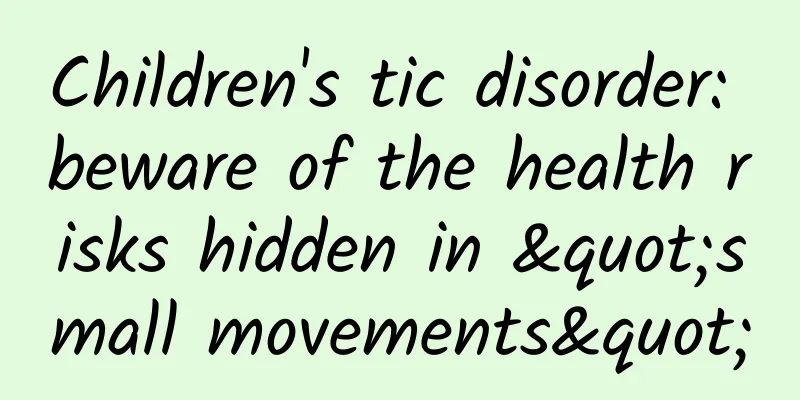Children's tic disorder: beware of the health risks hidden in "small movements"

|
This is the 5293th article of Da Yi Xiao Hu In the process of children's growth, parents often mistakenly believe that frequent blinking and unconscious shrugging are the manifestation of their children's lively and playful nature. However, these seemingly insignificant behaviors are likely to be the silent alarm of children's tic disorder. 1. What exactly is tic disorder? Tic disorder, also known as tics, usually occurs in childhood or adolescence. It is a neuropsychiatric disorder characterized by uncontrolled, rapid, and repetitive motor tics, such as frequent blinking and shrugging, or involuntary sounds, such as throat clearing, humming, and other vocal tics. 2. What are the typical manifestations of tic disorder? The main characteristic of tic disorder is the sudden uncontrolled muscle twitching of the body, which may cause two situations: either making some movements or making various sounds. In terms of movements, children may shake their heads inexplicably, blink frequently, grin or raise their eyebrows, shrug their shoulders unconsciously, kick their legs from time to time, and turn their wrists. At the same time, there are many symptoms in terms of vocalization. Some children will clear their throats frequently, some will suddenly make strange noises, and some will always make strange noises in their throats, which makes people feel puzzled. If you find that your child has these conditions, you have to be more careful. Generally speaking, this disease is more common in children aged 4 to 8 years old. When children grow to 10 to 12 years old, the symptoms are often the most severe, and then they will gradually alleviate. What is more gratifying is that some children have completely disappeared when they reach puberty. In addition, tic disorder often occurs together with attention deficit hyperactivity disorder, obsessive-compulsive disorder, anxiety, depression, sleep disorders and other diseases, which will make the child's symptoms more complicated. (Image source: Taishuai Medical Gallery) 3. What are the causes and predisposing factors of tic disorders? At present, the cause of tic disorder is not fully understood, but studies have shown that it may be closely related to the following factors: 1. Genetic factors It's like "planting a seed" in the child's genes, making them more susceptible to the disease. However, how this "seed" works in the body and the genetic basis behind it are still a mystery. 2. Neurochemical factors Children's tic disorder is related to a neural pathway in the brain called the cortex-striatum-thalamus-cortex (CSTC). This pathway is like a "highway" in the brain, which is responsible for transmitting various information. If it breaks down, the "traffic" will be paralyzed, which may make it difficult for children to learn new knowledge and remember things. In addition, if the content and ratio of excitatory amino acids and inhibitory amino acids that normally maintain balance in the body are imbalanced, it will also become an important cause of tic disorder. 3. Social and psychological factors If a child is sensitive, introverted, and pursues perfection, it is easy for the child to accumulate psychological pressure. If the family environment is depressing, the parents often quarrel, and lack emotional communication with each other, the child will feel more depressed. In addition, the parents' education is strict, and they are punished for mistakes. Excessive interference leads to the child's lack of autonomy, long-term mental tension, and suppressed thoughts, just like a big stone pressing on the heart. Once these situations are combined, it is easy to induce or aggravate tic disorders, just like lighting a "fuse" and detonating the "bomb" of the disease, and it also damages the child's mental health and causes symptoms to recur. 4. Other factors Giving children antipsychotic drugs for a long time and in large doses; upper cervical spine injury leading to ischemic damage in the brain; eating snacks containing additives; bacterial infection, allergies; abnormal levels of trace elements such as lead, zinc, and iron in the body, as well as staring at mobile phones and computer screens for a long time and physical fatigue are also common inducing factors. 4. How to prevent and treat tic disorders? 01 Precautions Children's tic disorder is also a chronic disease. Even if the child's symptoms seem to be alleviated after a short period of treatment, if the lifestyle is unhealthy, these tic symptoms may reappear at any time. Therefore, if you find that the child's condition has improved, you must work harder to prevent it from recurring. A healthy lifestyle is the key. The atmosphere at home should be warm and harmonious to make children happy. In terms of diet, children should eat less lead-containing preserved eggs and snacks with pigments or additives, and prepare more fresh fruits, vegetables, fish, meat, eggs and milk for their children. Encourage children to move every day, have a regular schedule, and go to bed and get up early. Parents should give less pressure and punishment, and more encouragement and guidance, and try not to let conflicts and violence occur at home. If children are allergic, they should avoid places with a lot of pollen and dry their bedding frequently. Electronic products can be viewed for a maximum of 2 hours a day, and game time should be strictly controlled. (Image source: Baijiahao) 02 Treatment Whether or not to treat the child depends on the severity of the tic symptoms. The doctor will give the child a comprehensive "examination". If the child's tic symptoms are relatively mild and do not interfere with daily life, you can wait for treatment, but you must go to the hospital for regular checkups. But if the child's tic symptoms are more serious and normal life is disrupted, then you must treat it quickly. The doctor will tailor the treatment plan to the child's specific condition and develop the most suitable personalized treatment plan for the child. 1. Psychological education Regardless of the severity of the child's symptoms, psychological education should be like a thread that runs through the entire treatment process. The main content includes helping children and parents to correctly understand the disease, letting children know that it is not a shameful disease and not to scare themselves. And how to actively manage the child's daily life, and reasonably arrange eating, drinking, defecating, urinating, sleeping, exercise, etc. 2. Behavioral therapy It is to help children learn to manage and control their tic symptoms. At present, there are several particularly effective first-line behavioral treatment methods, such as comprehensive behavioral intervention, which is to adjust children's behavioral habits from all aspects; there is also habit reversal training, which specifically helps children change those bad habits that are prone to tics and cultivate new good habits. Through these methods, children can be helped to alleviate symptoms step by step and move towards recovery. 3. Medication Medication can quickly alleviate the uncontrolled tics of children and bring them back to normal life. Its advantage is that it takes effect relatively quickly. If the child's tics are particularly severe and the symptoms need to be suppressed quickly, drug treatment is the first choice. There are several commonly used first-line drugs, such as sulpiride, aripiprazole, and clonidine. 4. Physical therapy Methods such as repetitive transcranial magnetic stimulation and transcranial microcurrent stimulation are non-drug treatments that do not require injections or medication, and can also be effective for tic disorders. 5. Traditional Chinese Medicine Treatment Traditional Chinese medicine has a significant effect in treating tic disorders, and it has unique advantages in preventing recurrence. It is easy to operate, does not require complicated instruments and cumbersome procedures, and has no side effects. No wonder more and more children and parents recognize it! It mainly includes taking Chinese medicine, acupuncture, massage, exercise (Tai Chi, Ba Duan Jin, etc.), ear acupoint pressing and Chinese medicine application therapy. 6. Treatment of comorbidities When the symptoms of the comorbidity are particularly obvious and have a greater impact than the tic disorder, the focus of treatment must shift to the comorbidity. In short, although childhood tic disorders seem complicated, don't panic, it is preventable and treatable. Parents can pay appropriate attention to their children's abnormal "little movements" in life, get help from professionals in time, and make early diagnosis and intervention. Parents whose children are already ill do not need to be overly anxious and worried. As long as they adopt a disease health management strategy that combines traditional Chinese and Western medicine and multidisciplinary collaboration under the guidance of professional doctors, the condition of most children can be effectively controlled and they can grow up healthily and smoothly. References: [1] Wang Xuefeng, Han Xinmin, Sun Kexing, et al. Expert consensus on TCM and external treatment of tic disorders in children (2024)[J]. Chinese Journal of Integrated Traditional and Western Medicine Pediatrics, 2024, 16(01): 1-7. [2] You Haizhen, Sun Kexing, Zhou Yifang. Tic disorder [1] Hu Yuchen, Wang Simeng, Chen Zilin, et al. Clinical characteristics of 474 children with genetically related tic disorders treated with traditional Chinese and Western medicine [J]. Journal of Beijing University of Chinese Medicine, 2024, 47(07): 961-970. [3] Research progress on immune-related mechanisms[J]. Journal of Educational Biology, 2022, 10(03): 242-247. [4] Xu Wanbing, Sun Dan, Liu Zhisheng, et al. Functional impairment and treatment indications of tic disorders in children[J]. International Journal of Psychiatry, 2024, 51(06): 1699-1702+1706. DOI: 10.13479/j.cnki.jip.2024.06.005. [5] Wang Shuai, Rong Ping. Research progress on relapse-related factors and treatment of tic disorders in children[J]. Chinese Journal of Traditional Chinese Medicine, 2023, 38(08): 3747-3751. [6] Fu Sai, Song Qian, He Xiangjun, et al. Advances in the application of comprehensive behavioral intervention in tic disorders[J]. Chinese Journal of Contemporary Pediatrics, 2024, 26(12): 1367-1372. [7] Groth C, Mol Debes N, Rask CU, et al. Course of Tourette syndrome and comorbidities in a large prospective clinical study [J]. J Am Acad Child Adolesc Psychiatry, 2017, 56(4): 304-312. PMID: 28335874. DOI: 10.1016/j.jaac.2017.01.010. [8] Hsu CJ, Wong LC, Lee WT. Immunological dysfunction in Tourette syndrome and related disorders[J]. Int J Mol Sci, 2021, 22(2): 853. PMID: 33467014. PMCID: PMC7839977. DOI: 10.3390/ijms22020853. [9] Chen Yanhui, Ke Zhongling. Psychological and behavioral intervention for tic disorder based on neurophysiological basis[J]. Chinese Journal of Child Health Care, 2024, 32(10): 1045-1049. Author: School of Nursing, Suzhou University Lu Jiahui Instructor: Shanghai Children's Medical Center, Shanghai Jiao Tong University School of Medicine Sun Kexing |
<<: Is laundry powder better or laundry liquid better? It turns out there are some considerations
>>: When pandas meet bamboo: a "taste revolution" spanning a thousand years
Recommend
Chinese research team has made breakthroughs in intelligent oxygen production technology on Mars. Human migration to Mars is no longer a dream!
On the 14th, the team of Professors Luo Yi, Jiang...
Fengyun Media Douyin live streaming practical course: 3 days to blow up the live broadcast room and 7 days of stable natural flow gameplay [Video course]
Fengyun Media Douyin live streaming practical cou...
Inventory | Characteristics of major information flow channels in 2018
Since the beginning of this year, super apps such...
How much does it cost to customize a dance school mini program in Huainan?
The main factors affecting the price of mini prog...
Winter Solstice "Nine Days"|When you count to ninety-nine days, will spring come?
The winter solstice has arrived, which means we h...
Who opened the first page of the book of the Qinghai-Tibet Plateau’s stratigraphic structure?
What is the painting on the rock? It is like a bo...
China Passenger Car Association: China Commercial Vehicle Industry Analysis Monthly Report in April 2021
1. Market Analysis Commercial vehicle market: Dem...
The reason why Android is lagging more than iOS has been found: it uses nearly 3 times more memory
When we mention Android and iOS, many people'...
Xiaomi YU7 starts large-scale road testing. Can it successfully compete with Tesla Model X when it is launched next year?
Xiaomi's first SUV, the YU7, is undergoing la...
The smiley face symbol was sold at a sky-high price of over 2.5 million. Why is NFT so valuable?
Let me first show you some priceless works of art...
Starbucks' self-harming PR
Starbucks, which has been doing bad things for a ...
That's not a bug, it's a new requirement
Ever since I started working in software developm...
With a low budget and high bid, how can you play Baidu bidding promotion?
Recently, I have sorted out several of the most f...
Realize various gesture operations for visualization
Source code introduction Realize various visual g...
Drones are still a niche toy industry or may usher in a blue ocean era
There is a question on Zhihu, an online Q&A c...









